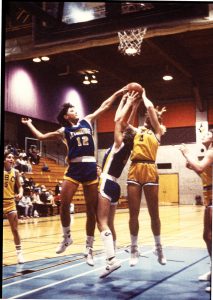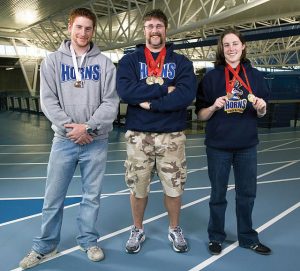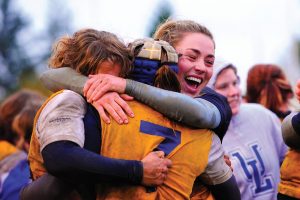You’ve felt the bleachers shake and the deafening roar of the crowd reverberate in your chest; you’ve swelled with pride as a trophy is raised on hallowed ice; you’ve been swept up in a sea of emotion as a tear trickles down the face of an Olympian; you’ve watched your five-year-old daughter get a high-five from her coach at soccer camp — you’ve experienced Pronghorn Athletics.
Over the course of 50 years, Pronghorn Athletics has produced national champions and record-setters, Olympians and mentors, all while being at the forefront of regional sport and wellness through the creation of state-of-the-art facilities and generations of community sport leaders.
It began simply. As the University was taking shape and establishing its academic tenor, a group of faculty and staff in the physical education department advocated for a program that would integrate physical education with intramurals and athletics. The group, many of whom had been educated or influenced by American colleges and universities, found the welcoming ear of President Dr. Sam Smith (LLD ’90).
“It wasn’t a really difficult sell at the time,” says Dr. Gary Bowie (LLD ’13), who served as a coach and athletic director and was one of the founding faculty involved in establishing the program. “Sam Smith already had a feel for what campus athletics was all about because he came from a U.S. background, so he supported it strongly when he came on the scene. We took it on and just moved forward. We felt athletics made a good contribution to education for the students and really was a part of the liberal arts philosophy, to be involved in academics along with other activities at the University to broaden your educational experience.”
Establishing a competitive athletics program required a utilitarian approach, as Bowie describes, that allowed the U of L to meet the conference threshold of five men’s sports and four women’s sports while also maintaining a sustainable bottom line.
Men’s and women’s basketball, with teams already established at what was then Lethbridge Junior College, were the easiest selections and allowed the University to be competitive out of the gate. Volleyball, wrestling, badminton, judo and curling rounded out the initial offerings, largely because they were all tournament sports that only required the University to participate in the league tournament at the end of the season to satisfy membership obligations.
Originally branded as the Bobcats, the University then adopted Chinooks as its moniker. Under that name, Dr. Wilma Winter coached the women’s basketball squad to the school’s first national title, in 1971.
Eventually, after a school crest was developed that featured a pronghorn antelope, the founding members advocated for Pronghorns as the official program name.
There would be some upheaval early on as the newly formed Canada West Universities Athletic Association struggled to find its footing. Not enough schools could be found for some sports so badminton and curling were eventually dropped, to be followed by wrestling. Judo also eventually left Canada West but not before the U of L made its mark by winning the conference championship in each of the final two seasons of competition, 1978-79 and 1979-80.
Canada West, recognizing that the U of L was still in its growing stages, let the school participate as full members throughout the 1970s even though it could not initially sustain the required number of sports. By 1981, the University had to abide by all league rules.
It was at this time that the Pronghorns added a cross country/track team and by 1982 had introduced men’s and women’s soccer programs, to be followed by men’s hockey in 1983.
The growth of athletics mirrored that of the University. In 1986, the Max Bell Regional Aquatic Centre opened, serving as a watershed moment for the city’s west side. Now, more than ever, the community was invited to become a part of the University community, and as Pronghorns men’s and women’s swimming was introduced in 1988, youth competitive swimming took on a new profile in southern Alberta. Champions emerged over the years at the provincial and national levels, as well as Paralympian Zack McAllister.
When women’s hockey came on board in 1997, to be followed by women’s rugby in 2000, it completed the current complement of funded programs. What followed was massive expansion to the University’s athletic facilities. In 2007, the 1st Choice Savings Centre for Sport and Wellness replaced the original physical education building, and in 2009 the University Community Stadium opened. Both facilities further extended Pronghorn Athletics’ reach into the community and now serve as hubs for high school and minor sport activity throughout the southern Alberta region.
 Over the years, each and every Pronghorns program has realized great successes at the conference and/or national level. In addition to the Chinooks first-ever national title in 1971, Pronghorns men’s hockey claimed the CIAU national crown in 1994, hoisting the University Cup at centre ice of Toronto’s Maple Leaf Gardens. The women’s rugby program dominated with a run of three successive national championships in 2007, 2008 and 2009, and eventually produced Olympians Ashley (Patzer) Steacy (BSc ’15) and Kayla Moleschi. The Pronghorns’ small but powerful track and field team also generated a steady stream of individual national champions, while both Jim Steacy (BASc ’09) and Heather Steacy have represented the U of L as Olympians.
Over the years, each and every Pronghorns program has realized great successes at the conference and/or national level. In addition to the Chinooks first-ever national title in 1971, Pronghorns men’s hockey claimed the CIAU national crown in 1994, hoisting the University Cup at centre ice of Toronto’s Maple Leaf Gardens. The women’s rugby program dominated with a run of three successive national championships in 2007, 2008 and 2009, and eventually produced Olympians Ashley (Patzer) Steacy (BSc ’15) and Kayla Moleschi. The Pronghorns’ small but powerful track and field team also generated a steady stream of individual national champions, while both Jim Steacy (BASc ’09) and Heather Steacy have represented the U of L as Olympians.
The men’s basketball team won its first-ever Canada West title in the spring of 1986 and then hosted the biggest basketball event in the city’s history, the Canadian Inter University Athletic Union West Regional tournament. Moved to the Sportsplex to accommodate overwhelming fan interest, the Horns eventually lost to the six-time national champion Victoria Vikings. With nearly 4,000 fans in the building, it still served as a national coming out party for the small school. In 2000, the Horns advanced to the CIAU Final Eight tournament in Halifax.
Beyond the efforts on the track, in the pool, on the mats, the ice and the hardcourts, Pronghorn Athletes have always excelled in the classroom. In the past year, 63 Pronghorn athletes were honoured as Academic All-Canadians, having achieved an 80 per cent academic average while also pursuing excellence in sport. That total is greater than 25 per cent of the school’s varsity athletes — the true essence of the student-athlete. Since the inception of the Academic All-Canadian program in 1990, a total of 849 Pronghorn varsity athletes have been named Academic All-Canadians.
Bowie says the impact of Pronghorn Athletics resonates far beyond the competitive sphere, pointing to the number of community sport associations that feature former Pronghorns as coaches and administrators. The program and its legacy have also created a climate of sport in southern Alberta that has attracted multiple large-scale events because of the capital of expertise that now exists in the region.
Today, Pronghorn Athletics continues to build on its storied past. This fall, the Horns hosted the Canada West Rugby Championships and in 2017, the University Community Stadium will welcome the CIS Women’s Rugby Nationals.
By reaffirming a commitment to excellence, Pronghorn Athletics has refocused on the student athlete, substantially increased community engagement and reached out to its alumni to welcome them back in the fold. As the U of L’s 50th anniversary beckons, the Pronghorn Wall of Fame is being rekindled, along with a number of other initiatives designed to further engage Horns alumni.
In recent years, the Pronghorn Scholarship Breakfast has been introduced. This year’s event saw more than 400 Pronghorn supporters attend Olympian Clara Hughes’ passionate presentationThe future of Pronghorn Athletics is guided by a new sport model that strives for excellence in academics and athletics, while also championing involvement in community initiatives by tracking team and individual volunteer hours. This model provides a framework for Pronghorn Athletics to report on progress and be accountable for its activities.
From the day Pronghorn Athletics was born it has always been about so much more than the games they play, rather it’s the opportunities created, the impact on community and the Pronghorn experience.
Story by Trevor Kenney.

